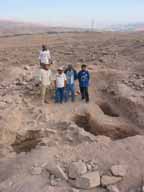 |
|
|
|
El Niño floods and Culture Change Paul S. Goldstein, Department of Anthropology, UCSD |
A major focus of my work is correlating past El Niño climate events with migration and culture change in the Andean region. No single climate phenomenon has had a more significant effect on human occupation in the Pacific Rim region than the ENSO or El Niño Southern Oscillation, yet the nature of this interaction is still poorly understood. The study area is on the northern fringes of the Atacama Desert, where precipitation normally totals less than 100 mm per year. Our fieldwork builds upon the MAS project's long-term study of archaeological settlement patterns in the Moquegua Valley of southern Peru. Current work focuses on surveying and precise dating of a) shifts in human settlement and agricultural patterns, and b) flood events detectable in river and tributary stratigraphy. Our 2003-2004 season was supported by the University of California Pacific Rim Research Program.
Ongoing field research is focusing on the historical correlation of
human settlement and agrarian change with major climatic events. Our archaeological
team is refining the sequence for Formative, Middle Horizon and Late Intermediate/Inca
Period occupations of the valley with test excavations at eight sites
discovered in previous years' survey work. Concurrently, our geomorphological
survey team, directed by Dr.
Francis Magilligan of Dartmouth College, is documenting the modern
and late Holocene flood history for the Rio Moquegua (also
known as Rio Osmore) and its tributaries. A concurrent project directed by Goldstein, Magilligan and geomorphologist Rebecca Manners is examining
the mechanics of flood-induced topsoil loss and regeneration over time.
Work to date has already demonstrated two major flood events that occurred
in AD 700 and AD 1300 (Magilligan
and Goldstein 2001). The correlation of these events to the cultural
sequence will permit us to compare prehistoric and historic patterns of
human response to dramatic climate events.
|
Copyright ©2003 Paul S. Goldstein. All rights reserved.
|




